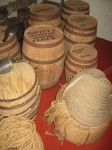Blog Categories
- Blog home
- Avalon (10)
- Central Newfoundland (2)
- Eastern Newfoundland (3)
- Labrador (1)
- St. John's (12)
- Western Newfoundland (3)
Related Travel Information
Cape Spear The Lighthouse, Battery and Berries
- Author: AlanMc
- Accommodation:
No trip to St. John’s is complete without a jaunt out to Cape Spear. It’s a short drive (15 km or 9 mi.) from downtown to the easternmost tip of North America. On a clear day the views of the Atlantic Ocean and the formidable rocky coast of Newfoundland are stunning. And on a foggy day you will understand why the lighthouse at Cape Spear was and still is an essential guide to seafarers entering the narrows into St. John’s harbour.
The lighthouse at Cape Spear is the oldest surviving one in Newfoundland. Built in 1835, it has been restored so the visitor can learn what it was like working and living in this once remote site. The storeroom on the ground floor contains the lighthouse supplies that were sent out on ship from St. John’s. Barrels of whale oil were lugged up the steep winding stairs to fuel the seven burners that produced a light intensified by reflectors. If the life of the lighthouse keeper was arduous, for the light had to be kept in operation continuously, it was equally challenging for his family who occupied confined quarters and had to make do with limited food supplies all through the winter. Outside, in the summer there would have been a garden for root crops that were harvested in the fall and stored for the winter months.
If there were children about they must have been carefully watched for the edges of the grounds of the lighthouse are precipitous cliffs. Today they are as just as dangerous and visitors are warned to be very cautious when walking around Cape Spear. Do not stray from the marked trails.
Below the lighthouse near the parking lot is an interpretive centre in which visitors can discover the history of the lighthouse and “twack” (meaning to browse in Newfoundland) in the gift shop which has numerous items relating to lighthouse keeping and Newfoundland’s maritime history.
Just beyond the Visitor Centre take a walk down to the Second World War battery. This massive concrete defensive complex was built to protect the entrance to St. John’s harbour, a critical port of call for convoys that crossed the north Atlantic bringing supplies and troops to Europe.
From the battery outlook you may see icebergs or Minke, Fin and Orca whales or a ship making for St. John’s. Keep an eye open for dolphins, porpoises, harbour seals and otters. The seabirds are plentiful and include large numbers of Manx, Sooty and Greater shearwaters that are most often seen far out at sea.
An activity that is sure to entertain the whole family visiting Cape Spear is taking one of the many hiking trails. Along the way be sure to stop for a feast of berries that are at their height in August. Raspberries and blueberries are particularly plentiful. For those more inclined to take on the challenge of a serious walk, Cape Spear trails are connected with the East Coast Trail System. Try the 3.7 km Blackhead Path that runs between the tiny village of Blackhead and Cape Spear. It is considered an easy trail but it does include a climb up and down the 120 metre rise at Blackhead.
You may want to inspect Cape Spear from the sea, and see it from the point of view familiar to mariners entering or leaving St. John’s harbour. Take a tour from the harbour offered by Iceberg Quest on which you will be able to get a better look at whales and, of course, the mighty icebergs that have floated here all the way from Greenland.


